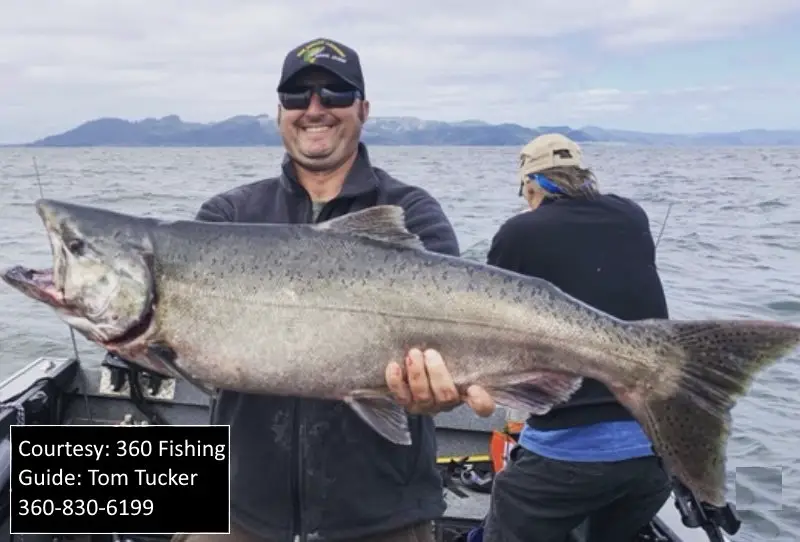Tule salmon, also known as tule Chinook, are a unique species of salmon found in the Pacific Northwest. Understanding what makes the tule salmon different can help anglers identify and catch these fish.
Overview of Tule Salmon
The tule salmon is one of the five species of Pacific salmon, along with chum, coho, pink, and sockeye salmon. Here are some key facts about the tule salmon:
- Species Name: Oncorhynchus tshawytscha
- Other Names: Chinook salmon, king salmon, blackmouth salmon
- Average Size: 10-30 lbs
- Run Timing: Late summer to fall
- Range: Columbia River and tributaries
Tule salmon are a run of Chinook salmon that enter the Columbia River system in the late summer and fall to spawn. They get their name from the Chinookan word “mitula̓ ” meaning white or pale salmon. This refers to their lighter colored flesh compared to spring and summer Chinook.
Unique Traits of Tule Salmon
There are a few key physical differences that set tule salmon apart from other salmon species and runs
-
Coloration – Dark grayish-green backs fading to silvery sides. Often develops an olive-green and black calico pattern.
-
Spots – Covered in small black speckles on their back and caudal fin. Much denser than summer Chinook.
-
Body Shape – Thicker in the middle with a slight hump on males. More rounded snout.
-
Scales – Loose sloughing scales from deterioration late in their lifecycle.
-
Flesh – Ranges from deep red to pale pink depending on maturity level.
-
Eyes – Become cloudy vs. clear when close to spawning.
-
Jaw – Males develop a hooked lower jaw that protrudes beyond upper.
Ideal Habitat
Tule salmon migrate hundreds or even thousands of miles from their ocean feeding grounds to reach their spawning habitats.
-
Ocean – They range from Oregon to Alaska while feeding at sea.
-
Estuaries – Use coastal estuaries like the Columbia River estuary to transition from saltwater.
-
Freshwater – Travel up the Columbia and Snake Rivers. Also enter lower tributaries like the Cowlitz River.
-
Spawning Sites – Spawn in the gravel beds of smaller tributaries and headwater streams.
Understanding where tule salmon live and migrate helps anglers know what areas to target during fishing seasons.
Best Fishing Techniques
Several techniques work well when targeting tule salmon:
-
Trolling – Offshore trolling near river mouths using flashers, hoochies, and bait.
-
Casting – Casting spinners, spoons, and plugs from shore and boats.
-
Jigging – Vertical jigging large spoons and blade baits along ledges and dropoffs.
-
Drift Fishing – Drift fishing cured eggs, prawns, or shrimp under a float.
-
Plunking – Plunking bait like eggs, shrimp, or sandworms near shore.
Adjust tactics based on location. In the ocean, target 20-60 ft depths. In rivers, focus on current seams, ledges, and structure.
Identifying Tule Salmon
When you hook a salmon, look for these characteristics to identify if it is a tule:
-
Olive green back with black calico blotches
-
Small black speckled spots on back and tail
-
Rounded, bullet-shaped body
-
Loose, fading scales
-
Protruding hooked lower jaw (males)
-
Cloudy eyes
-
Pink to pale red flesh
Learning the unique physical features of tule salmon will help anglers confidently identify them when caught.
Are Tule Salmon Good to Eat?
Tule salmon get a bad reputation as poor table fare, but this depends on handling:
-
When very mature, the flesh is soft and deteriorated.
-
However, when caught in the ocean and handled properly, the meat can be firm with rich flavor.
-
Bleed immediately after catching and keep chilled on ice.
-
Avoid playing fish to exhaustion before landing.
-
Check color and do a “poke test” to confirm good meat quality.
So while tule salmon may not be as prized as summer Chinook, they can provide good fillets for eating when cared for correctly.

What The HECK Is A TULE?! (Salmon Fishing Tips)
FAQ
FAQ
What kind of salmon is a tule?
Lower Columbia River Chinook Salmon Tules
Lower Columbia River Chinook salmon have three life history types including a spring run, a fall timed component referred to as tule Chinook, and a late-fall timed component referred to as bright Chinook. From a harvest perspective, tule Chinook are the most problematic.
What is the difference between Urb and Tule salmon?
The first thing that SCREAMS tule is the dense heavy spotting. Compare how the URB’s have such a sparse spot pattern. The next-most obvious feature is the overall body shape. Tules tend to be short for girth. That tule is as big or bigger around than the other four fish, yet it is clearly shorter than the rest.
What is the best tasting salmon to eat?
The best-tasting salmon is often considered to be King Salmon (Chinook), due to its rich, buttery flavor and high-fat content, according to culinary websites.
